Talking to Students at Kyoto Seika University
24/11/2013 12:12 (GMT+7) Font size:  
Kyoto, Japan, 23 November 2013 - His Holiness the Dalai Lama’s first visitor today was Mitsuko Shimomura, who had come to conduct a television interview with him. In her distinguished journalistic career she became the first woman Editor-in-Chief of the Asahi Journal, a major national-circulation weekly magazine, before opting to work as an independent writer and journalist, TV commentator and public speaker. Having moderated the first dialogue between His Holiness and scientists in Japan a year ago, the first thing she wanted to know was how he felt the dialogue is developing. 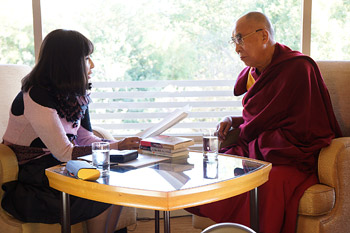
| Mitsuko Shimomura interviewing His Holiness the Dalai Lama in Kyoto, Japan on November 23, 2013. Photo/Jeremy Russell/OHHDL
|
“As you know, I’m very happy that a dialogue is taking place between science derived from ancient Indian thought and modern scientists. I am happy too that growing numbers of people are showing interest in this here in Japan. This exchange is helpful. Modern understanding of matter and cosmology is immensely useful, while the understanding of the mind found in ancient Indian, particularly Buddhist, science is very advanced; combining them can be mutually enriching.”
Noting that scientists are coming to recognise the effects of the mind on physical health, His Holiness elaborated that the sense of relaxation associated with inner peace does not only involve being physically at ease. If you are nagged by worry or smouldering with anger, you’re not really relaxed. The key to relaxation is peace of mind. The relaxation gained from alcohol, drugs or just listening to music may seem attractive, but it doesn’t last.
His Holiness told her he was interested in dialogue with Japanese scientists because their cultural background is influenced by Buddhism, whatever their personal beliefs. Some scholars have described Buddhism as a science of the mind, not that he wanted to mix or confuse modern scientific and Buddhist approaches. He spoke approvingly of how his old friend Francisco Varela used to say: “Now, I’m wearing my Buddhist hat,” or “I say this wearing my scientist’s hat.” He said he mostly tries to put on his scientist’s hat when he’s talking to scientists.
He went on to discuss the Buddhist view of a physical world consisting of particles and the continuity of consciousness. While some levels of consciousness depend on the brain - for example, eye consciousness clearly depends on the eye and the brain - subtler levels of consciousness do not. The subtlest level is what is known as Buddha nature. He also pointed out that Buddhism is the only spiritual tradition that questions the concept of self, describing it as merely designated on the basis of the subtle body and mind.
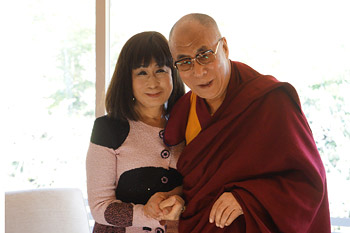 | | Mitsuko Shimomura and His Holiness the Dalai Lama after their interview in Kyoto, Japan on November 23, 2013. Photo/Jeremy Russell/OHHDL |
Ms Shimomura changed the subject to the secular ethics His Holiness discusses in his book ‘Beyond Religion’. He clarified that the word ‘Beyond’ in the title did not mean that the book was about something higher than religion, but that religions by their nature have limits or boundaries. The practice of Buddhism, for instance, is only for Buddhists and the practice of Christianity is only for Christians. However, there are basic human values, like love, compassion, contentment and self-discipline that are common to all major religions, without being limited to any. He refers to such principles as secular ethics.
The next question concerned why His Holiness retired from his political responsibilities. He told her that it was part of his intention, cherished since childhood in Tibet, to further democracy. Once Tibetans had elected leaders for the third time in 2011, he felt it was time to step back. Moreover, he also put an end to custom of the Dalai Lamas wielding political power in the future.
“Now I am truly just a simple Buddhist monk,” he declared, “whose commitments are to telling people how to live a happy life and how to promote religious harmony.”
About the current situation in Tibet, he conceded that living standards have improved.
“However, out of fear, Chinese authorities distrust Tibetans and continue to insist that Tibet’s unique language and written script, our unique cultural heritage are indications of separatist tendencies. Look at India, a country where many languages and religious traditions live side by side but pose no threat to the country’s integrity.”
Challenged as to whether he continues to be optimistic about the future of Chinese-Tibetan relations, His Holiness repeated what he has often said before that the Tibet struggle is a between the power of truth and the power of the gun. In the short term, the power of the gun is stronger, but in the long run the power of truth wins.
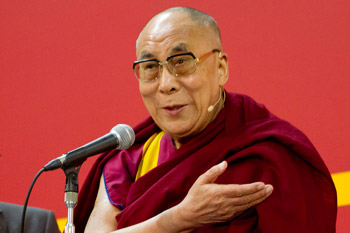 | His Holiness the Dalai Lama speaking at Kyoto Seika University in Kyoto, Japan on November 23, 2013.
Photo/Office of Tibet, Japan |
When he arrived at Kyoto Seika University after lunch, His Holiness was received by President Sigeaki Tsubouchi, the Dean Hiroshi Akasaka, and Rebecca Jennison, Moderator of his talk. Before 1600 teachers and students assembled in the gymnasium, the President introduced him and told the students he hoped they would enjoy what His Holiness had to say and would learn something from it.
His Holiness opened as he usually does:
“Respected teachers, brothers and sisters, I am happy to be here to meet you students. I’d like to thank you for your invitation. I’m always happy to meet people, especially members of the younger generation; you are the ones who will build this new century. Those like me who are in their 60s and 70s belong to the 20th century, an era that is gone, that only exists as a memory. We cannot change the past, but we can reshape the future. You young people have the opportunity to create a happier, better future.”
He spoke about the marvellous developments, but also the immense violence that marked the 20th century, violence that brought tremendous suffering, including nuclear attack, to Japan. No one wants that kind of violence, he said, and in order not to repeat it we have to ensure that the 21st century is characterised instead by non-violence.
“You can do this. You can create a happier, more peaceful century. I understand that today is the 45th anniversary of the founding of this university and that from the outset there has been an emphasis on the teachers and students being on the same level. The 7 billion human beings alive today are equal in their potential. Right now, I am the speaker and you are the audience, but we are otherwise the same. If I stress that I’m a Buddhist or that I’m the Dalai Lama it creates a distance between us. To think that I’m a special or holy person would just be nonsense.”
He said that there are differences between us of faith and nationality and among those groups there are those who are rich and those who are poor, but all have a right to live peacefully. This idea of human rights is what freedom is about. It takes for granted the idea that human nature is gentle. This is why concern for the well-being of others makes us free.
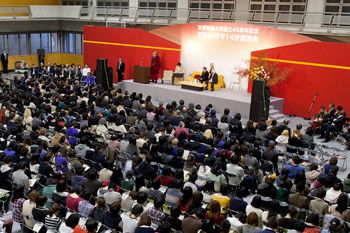
| A view of the stage at Kyoto Seika University during His Holiness the Dalai Lama's talk in Kyoto, Japan on November 23, 2013. Photo/Office of Tibet, Japan
|
“Education is not just about listening to teachers; it’s also about learning to analyse to think for yourself. Being able to say ‘Yes sir,’ is not enough; you also have to ask questions. Questions and argument are helpful; good teachers welcome questions. In order to exercise creativity, freedom is essential. We have to be realistic. We can’t be taken in by appearances; we have to take a realistic approach. It’s through education that we come to grips with reality. Understanding grows from first hearing or reading, followed by analysis and experiment, and then really thinking about it. This is one of our unique human abilities, which requires that we look at reality from more than one angle.
“Another factor is that in our investigation our mind should be neutral, not biased or clouded by anger or attachment. Anger and hatred lead to fear, whereas compassion and concern for others allow us to develop self-confidence, which breeds trust and friendship.”
His Holiness explained that compassion is not an exclusively religious attitude, but has biological roots. We all receive affection from our mothers. Affection is in our blood. We all have the potential to show others love and affection, but as we progress in our materialistic world, these values tend to remain dormant. We can develop them on the basis of common sense, common experience and scientific findings. He said that response to the recent tragedy in the Philippines is an example of how such values are awakened; people have done what they can to help simply because others are suffering and in need of support.
Among questions from students, His Holiness was asked if he feels optimistic about the future and he answered yes, because humanity seems to be growing more mature; scientists are paying more attention to our inner values, to the study of mind and the emotions. There is a clear desire for peace and concern for the environment.
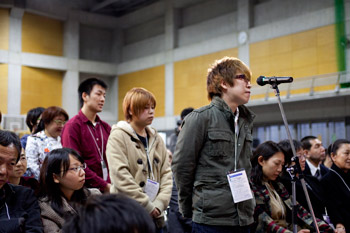
| Students lined up to ask His Holiness the Dalai Lama questions during his talk at Kyoto Seika University in Kyoto, Japan on November 23, 2013. Photo/Office of Tibet, Japan
|
A young woman particularly caught his attention because she seemed distressed about how to move forward in her life. He told her that she could perhaps learn from the example of a 78 year old who has faced all sorts of problems in his life.
“You should use your intelligence to the full and cultivate warm-heartedness towards others which will make your life better day by day, week by week. Don’t give in to helplessness. You’re young; you can take part in building this new century. The important thing is to do what you can to help others and at least avoid anything that brings them harm. This is the way to build self-confidence, without creating grounds for regret. Leading your life honestly and truthfully will create trust and friendship. Of course, sometimes things go wrong; that’s normal. But we have a saying in Tibetan, ‘Nine times fail, nine times try again.’”
In answer to other questions, His Holiness pointed out that because the world has become so interdependent, old notions of seeking your own victory at the cost of the destruction of your opponent only brings harm to you too. He stressed the need to make this a century of dialogue instead of violence, even suggesting that we should aim for complete demilitarisation. He pointed out that the money saved on defence could be used to further education, health and closing the gap between rich and poor.
He advised a student who wanted to know how to channel her ambition positively:
“Analyse it; be realistic. When you have to make a decision, analyse the situation first, consult other people. Sometimes we make impulsive decisions and then hesitate about putting them into effect. Once you’ve reached your decision, stick to it. So, be realistic, analyse, make your decision and then make the effort to follow it through.”
At the end, the students who had asked questions filed onto the stage to offer His Holiness a beautiful bouquet of flowers. He smiled, shook each of their hands and posed with them for a photograph. After offering white silk scarves to the President, Dean and Moderator, as is the Tibetan custom, he bowed to the smiling audience and waved goodbye.  http://www.dalailama.com/
|